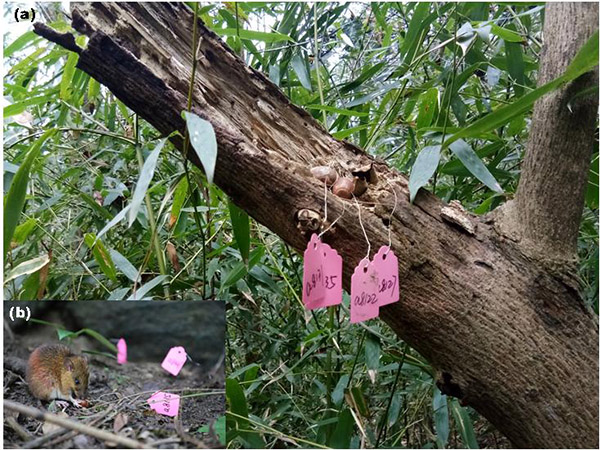In nature, apparent competition, apparent mutualism and apparent predation among sympatric tree species are three animal-mediated indirect interactions, and play a significant role in maintaining the biodiversity of plant communities. Many factors (e.g., seed traits, interspecific synchrony of seed rain) may shape these indirect interactions under animal predation, but we have limited knowledge regarding if and how these factors alter the animal-mediated indirect seed-seed interactions of sympatric tree species.
Prof. Zhibin Zhang's team from the Institute of Zoology, Chinese Academy of Sciences, recently published a paper entitled “Interspecific synchrony of seed rain shapes rodent-mediated indirect seed-seed interactions of sympatric tree species in a subtropical forest” in the Ecology Letters.
They tracked the seed fates of six paired sympatric seeds presented to rodents in both monospecific and mixed plots in the subtropical forest ecosystems of the Dujiangyan Region, Sichuan Province, southwestern China. By assessing the seed dispersal success, they tested two hypotheses: the seed‐trait similarity hypothesis and the seed rain synchrony hypothesis in terms of seed dispersal. They found that apparent mutualism (cooperation) was associated with the interspecific synchrony of seed rain both seasonally and yearly, whereas apparent competition or apparent predation (antagonism) was associated with interspecific asynchrony of seed rain either seasonally or yearly, supporting the seed-rain synchrony hypothesis. This study suggests that the interspecific synchrony of seed rain plays a key role in the formation of animal‐mediated indirect interactions, which, in turn, may alter the seasonal or yearly seed rain schedules of sympatric tree species and then promote the coexistence of sympatric tree species.
Yang, X., Yan, C., Gu, H. & Zhang, Z*. (2019). Interspecific synchrony of seed rain shapes rodent-mediated indirect seed-seed interactions of sympatric tree species in a subtropical forest. Ecol. Lett. 10.1111/ELE.13405.
Website: https://onlinelibrary.wiley.com/doi/full/10.1111/ele.13405.

Figure 1 (a) Tagged acorns of oak (Quercus variabilis) were hoarded in the trees by animals; (b) The colored marked chestnut rat (Niviventer fulvescens) was hoarding tagged acorns of oak (Quercus variabilis).

Figure 2 Proportions of scatter‐hoarding of seeds by sympatric rodent dispersers in monospecific and mixed stations. Qv, Quercus variabilis; Ca, Choerospondias axillaris; Co, Camellia oleifera; Qs, Quercus serrata; Cg, Cyclobalanopsis glauca; and Cf, Castanopsis fargesii. Neighbourhood treatments: monospecific, monospecific stations; mixed, mixed stations.


